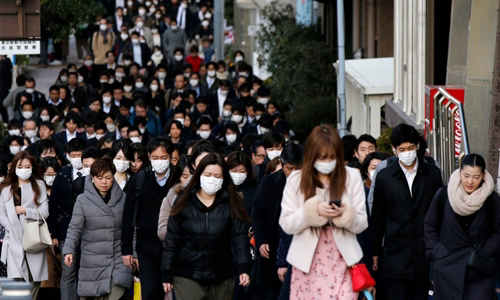On the evening of January 18, when the taxi association party took place in a boat on the Sumida River, 90 guests were unaware that the corona virus might be around them.
Due to the rain, the windows on the boat were closed, while dozens of drivers in Tokyo, Japan celebrated the New Year. A few days later, a driver in his 70s who attended a feverish party. The test results on February 13 showed that he was positive for nCoV, a virus strain originating in Wuhan, China that has killed more than 2,700 people.

Tracing the Japanese Covid-19 patient cluster Photo: AP
The driver's mother-in-law was killed the same day he received the test results. The woman in her 80s said she felt tired from January 22. 6 days later, she requested medical assistance, but was asked to continue monitoring her health status herself.
She was hospitalized on February 1 after being diagnosed with pneumonia. Her respiratory capacity weakened rapidly, so she was transferred to another hospital on February 6 and tested for nCoV on February 12. After her death, test results showed that the woman had Covid-19.
Tokyo authorities began tracing the infected driver's meetings as soon as he discovered he was the son-in-law's son-in-law. All party participants on the boat were tested, of which 10 cases were positive for nCoV, including one patient who used to serve passengers from Wuhan.
Many other cases did not go to parties, but still contracted nCoV after interacting with people on boats, such as a female taxi driver association employee. A doctor in his 60s was also positive for nCoV after having a meal with a nurse, the wife of a party driver.
The party on the Sumida River is the second largest case of nCoV infections in Japan, after Diamond Princess yacht, where 634 cases were found and three deaths. The situation became more urgent after the passengers left Diamond Princess. Experts fear some people who are eligible to go ashore remain at risk of being positive for nCoV, then "spraying the virus" on land in a similar way to a river party.
Japanese Health Minister Katsunobu Kato said it had entered "another phase" in the battle against Covid-19. "Doctors all agree that the number of infections will increase in the future, so strong measures need to be taken," Kato said Monday. Tokyo announced a grant of US $ 139 million to prevent the epidemic, including strengthening testing and isolation.
The spread of nCoV outside of Chinese territory is alarming by the public, as the number of infections in Korea has reached nearly 900, most of which is linked to the Tan Thien Dia church in Daegu city. In Singapore, the government has also identified five "patient clusters" and is investigating their link.
"What we are worried about is the ongoing infection in the community in countries outside China," said Raina MacIntyre, an expert at the Kirby Institute of the University of New South Wales, Australia. "Because once the disease spreads and spreads on two continents, Covid-19 will become a pandemic."
Medical experts say most cluster infections are difficult to understand and this is especially true of the current situation, in which many patients have no symptoms. If these people were able to transmit nCoV, it would be much more difficult to control the spread, because the pathogen was transmitted accidentally. Seven cases at a party on the Sumida River said they had no symptoms.
However, David Heymann, an epidemiologist at London School of Hygiene and Tropical Medicine, UK, noted there is no clear evidence that people who have no symptoms can spread the disease, adding that experts is waiting to receive data from countries outside of China.
"China has so many patients that they cannot scrupulously record data. How easily is this virus transmitted from person to person? We don't know that yet," said Dr. Heymann. Health officials are also carefully studying cluster cases in Japan to predict future Covid-19 activity.
Another "patient cluster" was uncovered at a hospital in Wakayama province, where a surgeon, his colleague and his wife were both positive for nCoV. Two patients who had been to the hospital were also infected with the virus, including a 70-year-old farmer who went to see the doctor when the surgeon was off work.
The other person who became infected with nCoV after coming to the hospital was in his 60's. His mother, wife and younger brother also fell ill. Another case is the hospital's 30-year-old nurse, who once boarded Diamond Princess to help with medical missions.
Wakayama Prefecture governor Yoshinobu Nisaka said he did not rule out the possibility that infection had occurred inside the hospital. "We are having a hard time understanding how those people are infected," he told a press conference on February 15.
The same situation happened in Aichi Prefecture, when four people were found to be infected with nCoV, including two who had just returned from Hawaii, the US and their friends. The Japanese government has called on people to consider working from afar and to avoid unnecessary meetings.
Dominic Dwyer, an expert at the University of Sydney, Australia, said the government's identification of "patient clusters" is a good sign, because it proves that the public health monitoring system is working.
"I think the concern is whether there are other patient clusters that the government has yet to discover? Identifying them shows good investigation. But the end effect is how long it takes to wait." replied, "Dwyer said.



 CarolynSproles
CarolynSproles







